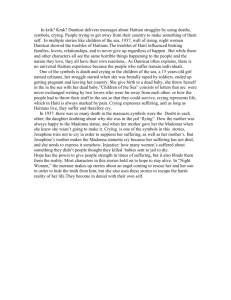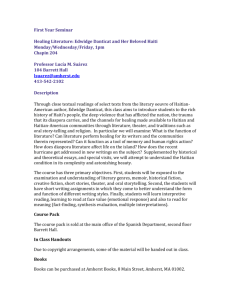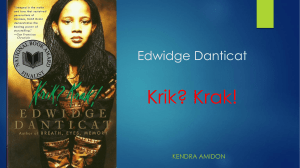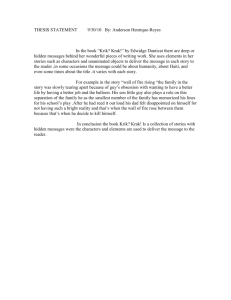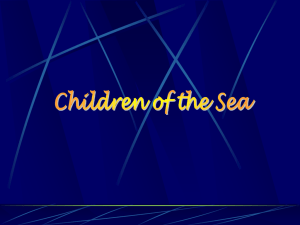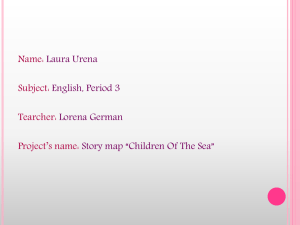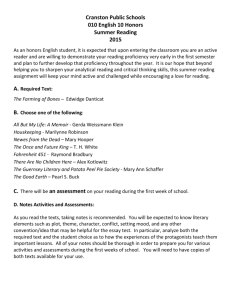Amanda Marshall Amanda Marshall Dr. Magill English 432 07
advertisement
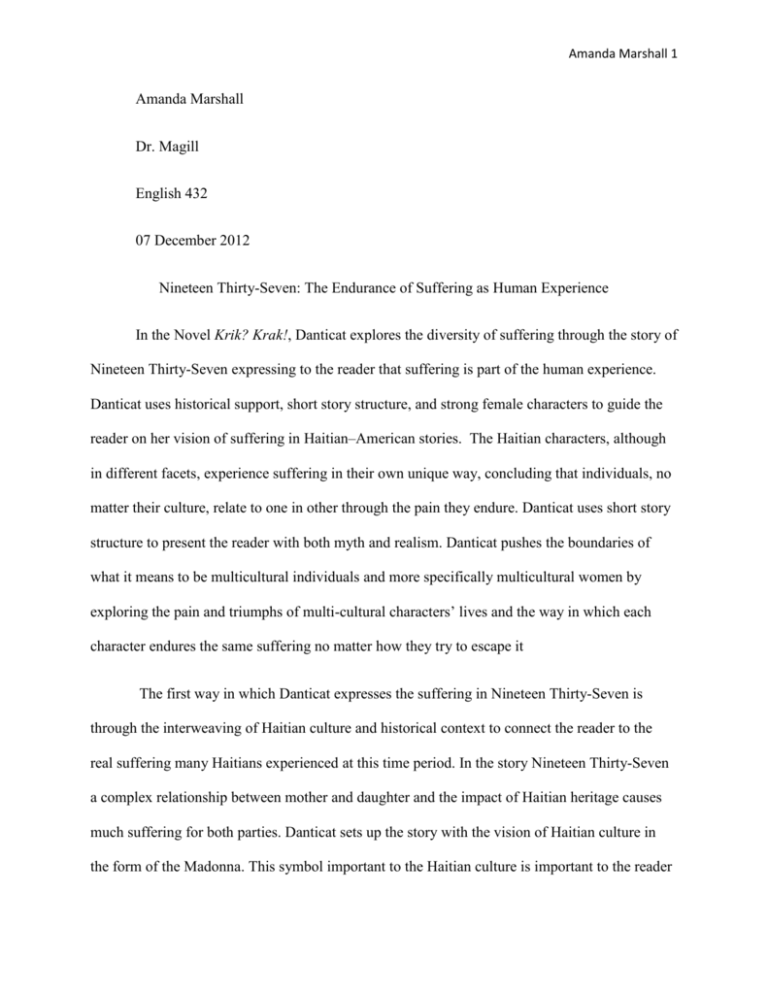
Amanda Marshall 1 Amanda Marshall Dr. Magill English 432 07 December 2012 Nineteen Thirty-Seven: The Endurance of Suffering as Human Experience In the Novel Krik? Krak!, Danticat explores the diversity of suffering through the story of Nineteen Thirty-Seven expressing to the reader that suffering is part of the human experience. Danticat uses historical support, short story structure, and strong female characters to guide the reader on her vision of suffering in Haitian–American stories. The Haitian characters, although in different facets, experience suffering in their own unique way, concluding that individuals, no matter their culture, relate to one in other through the pain they endure. Danticat uses short story structure to present the reader with both myth and realism. Danticat pushes the boundaries of what it means to be multicultural individuals and more specifically multicultural women by exploring the pain and triumphs of multi-cultural characters’ lives and the way in which each character endures the same suffering no matter how they try to escape it The first way in which Danticat expresses the suffering in Nineteen Thirty-Seven is through the interweaving of Haitian culture and historical context to connect the reader to the real suffering many Haitians experienced at this time period. In the story Nineteen Thirty-Seven a complex relationship between mother and daughter and the impact of Haitian heritage causes much suffering for both parties. Danticat sets up the story with the vision of Haitian culture in the form of the Madonna. This symbol important to the Haitian culture is important to the reader Amanda Marshall 2 to notice because it is a foreshadowing of the tale rich in historical context, of which the narrator is about to tell. Haitian heritage often mixes such religious symbols with witchcraft and folk tale to create a distinct spiritual experience. “The presence of Vodou is important, not only in the shaping of the Haitian context, but also as an interpretive lens through which the spiritual world is accessed and through which a highly symbolic world, as depicted in the Book of Revelation, is signified” (Charles 187). The Madonna is a steady symbol in the book of the closeness to religion that many Haitians feel as well as a figure of companionship for Josephine throughout her journey of suffering, as her mother indicates, “Maybe you will have some flesh to console you. But if you don’t, you will always have the Madonna” (Danticat 75) The narrator, Josephine, within the first two paragraphs of the story expresses to the reader the physical pain she endures “my bones aching from the thought of another trip to the prison in Port-au-Prince. But, of course, I had to go” (Danticat 58). Josephine tells the reader of the Massacre River, a river in which much tangible suffering occurred for the Haitians, “Haitians were slain even as they attempted to escape to Haiti while crossing the fatefully named Massacre River that divides the two nations” (Turits 591). Here Danticat uses historical support of real events in Haitian history to connect the reader to the view of the Haitian characters. Even the title “Nineteen Thirty-Seven” sets up the reader for the gruesome history, “In October 1937, the Dominican Army systematically massacred thousands of Haitian residents in the Dominican Republic […] Although estimates of the massacre and its death toll very widely, it seems likely that twelve thousand Haitians died during at least a week of violence throughout the country” (Roorda 301). On the journey to see her mother in prison Josephine expressed to the reader that she was born on the day that started it all, forever connecting her to the painful legacy of her heritage “I Amanda Marshall 3 had been born on the night that El Generalissimo, Dios Trujillo, the honorable chief of state, had ordered the massacre of all the Haitians living there” (Danticat 59). She also explains the American influence on the Haitians saying that “the yellow prison building was built like a fort, as large and strong as in the days when it was used by the American marines who had built it. The Americans taught us how to build prisons” (Danticat 61), speaking in reference to the United States Marin occupation of Haiti until 1934 (Roorda 305). Visiting her mother in prison is painful for Josephine and she agonizes as she watches her mother’s health deteriorate from visit to visit. When she is there visiting her mother in prison she explains that she cannot muster up enough strength to speak to her mother, clearly suffering from the agony of her mother being imprisoned. Josephine’s mother, Manman, who was “accused of having wings of flame” (Danticat ,61), and more specifically was accused of causing the death of a child, as were all the women in the prison “ They were said to have been seen at night rising from the ground like birds on fire.. A loved one, a friend, or a neighbor had accused them of causing the death of a child. A few other people agreeing with these stories were all that was needed to have them arrested. And sometimes even killed” (Danticat 66). Manman’s arrest takes nod from the Haitian culture and the spirituality of the people. Danticat paints the picture in Nineteen Thirty-Seven that through this experience both generations feel the strain on their relationship, and only more impact on the generation before is yet to be revealed. Danticat continues to bring the Haitian heritage and historical accuracies together through the story of Manman’s arrest advancing the reader through the events and leaving the reader no other way to interpret these events of witchcraft and mysticism than in the context of the culture. The depiction of how invested the Haitian culture is in witchcraft comes to life when Josephine tells of the hardships the women in the prison must suffer because of what they have been Amanda Marshall 4 accused, “And before the women went to sleep, the guards made them throw tin cups of cold water at one another so that their bodies would not be able to muster up enough heat to grow those wings made of flames, fly away in the middle of the night, slip into the slumber of innocent children and steal their breath” (Danticat 65). Josephine’s narrative continues to tell the story of the rituals she and her mother preformed at the Massacre River and how connected her family is with the history of the river, although Josephine does not quite understand their meaning; her mother explains “We were saved from the tomb of this river when she was still in my womb. You spared us both, her and me, from this river where I lost my mother” (Danticat70). Danticat again utilizes the loss of the Grandmother to the river as historical support that connects the river to the family’s suffering and the suffering of many in the Haitian culture as many other families also lost loved ones to the river, Josephine narrates the scene “From the Haitian side of the river, she could still see the soldiers shopping up her mother’s body and throwing it into the river along with many others” (Danticat 70). Historical accounts from the massacre depict exactly the scene in which Josephine recounts, “Many of the survivors who fled across the border to Haiti had seen their entire families murdered, the adults hacked with machetes or strangled, the children dashed against rocks or tree trunks” (Roorda 306). Danticat, being of Haitian decent, uses her knowledge of her heritage in her writing, “whether she knows it or not, the position of the Caribbean woman writer and her work is influenced by historical assumptions about gender, race, and writing” (Fulani 71). Throughout these historical references in the story Danticat creates for the reader the suffering endured not only by the characters in the story but also of the victims who lived these tragedies themselves. The suffering of Josephine because of her connection to the river and her confusion surrounding Amanda Marshall 5 her mother’s imprisonment as well as the suffering of Manman in prison bring the reader closer to the Haitian heritage as well as provide a personal connection to the characters. Throughout Krik? Krak! Danticat uses a short story structure by creating an overarching theme of culture and although not linking characters or settings in the stories through the theme using the structure only enhances her works. Not only the book as a whole, but the short stories themselves, resembles the way in which Haitians told of their heritage through the use of oral histories, “The short story cycle looks back to oral traditions of narrative while embodying signs of modernity” ( Davis 26). This use of short story vignettes and oral story telling makes the events in the novel more relatable and realistic to the reader. Using this strategy in the story Nineteen Thirty-Seven, Danticat can further entrap the reader in feeling the suffering of the characters and the human experience. In Nineteen ThirtySeven the reader finds themselves in the midst of an oral tradition as if the readers own grandmother had been telling the tale. Danticat uses the narrator Josephine to unite the reader to her Haitian culture and the suffering of her family through the culture. Danticat presents the story through the voice of Josephine, who among other things is a daughter, skeptic, and victim of the events in the story, causing the reader to experience the story as all these things as well. Furthermore, the use of a woman as the narrator provides a sense of empowerment to the characters that though are suffering; still have a chance to be heard. For example, although Manman is imprisoned, through the voice of her daughter, the narrator, the reader still gets a chance to hear her story and know that her story of anguish and the Massacre River will live on. Another way that the short story structure and use of oral story telling advances the readers connection to the theme of suffering is when Josephine encounters a women who claims to be a Amanda Marshall 6 part of the assembly of women who went on voyages to the Massacre River. Josephine asks the woman, Jacqueline, questions that she answers correctly proving that she is in fact part of the group, “If she were really from the river, she would know. She would know all the things that my mother had said to the sun, as we sat with our hands dipped in the water, questioning each other, making up codes and disciplines by which we would always know who the other daughters of the river were” (Danticat 76). Through this question and answer, this oral exchange between women, they are united in the suffering that the river had caused their mothers, and the reader now sees the importance that the mothers have instilled to their daughters in keeping the history alive. The reader then feels more sympathy for the characters, relating the suffering in the story to the suffering their own families have dealt with. This oral history dramatizes the stories to forge greater bonds between the reader and the characters, making the theme of suffering more relatable and allowing the reader to take the agony from the narrator and carry it with them. The characters in Nineteen Thirty-Seven exemplify in many ways strong female protagonists, which Danticat often creates in her works. Although these women are repressed and struggling with their own personal difficulties, they are still the focal point of the story proving that through their existence the narrative is formed and without them there is no story at all. The women in this story take the role of mother, daughter, friends, and a person who shares a common bond, a link to the human experience, demonstrating that all women are not alone in the struggle against the suffering that the Massacre River has caused. The use of these courageous women as lead characters ensures that although these women do endure pain, their voice through the story makes their pain real and their pain heard. Throughout Nineteen Thirty-Seven Danticat, “acknowledges both the strength of these women survivors of violence and the power of their testimony” (Chen 50). Also the connection Amanda Marshall 7 of the female characters conveys to the reader that the women have formed a community to gain their strength in, for example the women who make the pilgrimage to honor their mother. This strength of the female characters is only heightened in their bond with other females in the novel. For example when the women go to the river they take the strength from their mother as if their mother was the start to a larger dynasty, “We were all daughters of that river, which had taken our mothers from us. Our mothers were ashes and we are the light. Our mothers were the embers and we are the sparks. Our mothers were the flames and we were the blaze” (Danticat 71). This use of women as characters also relates to both the heritage of Haitian culture and to the structure of the story as oral history because women, especially in Haitian cultures, are usually the passers of oral history. Without women such as these the history would be lost, what is the suffering of human experience without the relief of knowing you have endured something, “The telling of stories heals past experiences of loss and separation: it also forges bonds between women by preserving tradition and female identity as it converts stories of oppression”(Davis 68). In conclusion, Danticat uses historical support, short story structure and strong female characters to advance the overall themes of suffering in the story of Nineteen Thirty-Seven. In the genre of African American studies as well as literature historical evidence brings about a new dimension to the reader by exposing them to a culture in which they may have otherwise never experienced. Throughout this story Danticat examines the pain in which many Haitians had to suffer in the historical time period of which the work takes place, and is named. Using these historical markers as guides the reader can journey to the scene in which the characters are living Amanda Marshall 8 and relate to the suffering they feel. The events that took place at the Massacre River are critical to understanding the story and the lives of the characters in it. Not only are the actual events important to the advancement of the plot, development of the characters and revelation of the theme but just as much so is the culture and heritage of the Haitian people. Without this knowledge of the strong religious customs and the entanglement of witchcraft and folklore the reader cannot fully grasp the story for all that it is worth. Being such an imperative piece to this stories puzzle, Danticat executed the Haitian history in a way that the reader will not only pick up on but remember. The use of short story structure and the narration as a resemblance or oral history traditions further enhances the historical context of the story while bringing in a personal element of ratability. Danticat, through using Josephine as the narrator in the novel gives the reader a since of insight into not only the tradition of oral story telling but a view in which they can relate to. The reader see’s the world and the culture as how the characters are enduring it. The story is not told from an outsider, nor is it told as looking back on the past. The use of this narration allows the reader to transport to Nineteen Thirty-Seven, allowing the reader to better understand the theme of suffering in which the characters are entangled. This method also lets the reader relate and feel more sympathy for the characters because the reader feels they are hearing the story from a human source that has a first hand account, not a textbook or a professor’s second hand knowledge. Without the main characters in a story there is nothing to base the story around. Danticat’s use of powerful female characters brings Nineteen Thirty-Seven to life. The women although, through much suffering, are telling their story of heritage and triumph through their Haitian roots. Without these fierily determined ladies the story of Nineteen Thirty-Seven could Amanda Marshall 9 not be told. Danticat uses Josephine’s narration to move the reader by telling the story of her family and the suffering of not only these few named women in the story but those who have lost their mothers, and those who were lost to the events of the year. Without these women, the keepers of the Haitian culture, the passers on of the oral history Danticat’s vision could not be told. The use of historical context, short story structure and women as lead characters, are all techniques through which Danticat brings the reader into theme of suffering as human experience. Nineteen Thirty-Seven examines this theme through Haitian heritage, in that the reader see’s not only the story of the Massacre River told by the narrator but also the story of her own Haitian heritage that Danticat wishes to share. Amanda Marshall 10 Works Cited Danticat, Edwidge. Krik? Krak! New York: Soho, 1995. Print. Charles, Ronald. "Interpreting The Book Of Revelation In The Haitian Context." Black Theology: An International Journal 9.2 (2011): 177-198. Academic Search Complete. Web. 6 Dec. 2012. Turits, Richard Lee. "A World Destroyed, A Nation Imposed: The 1937 Haitian Massacre In The Dominican Republic." The Hispanic American Historical Review 3 (2002): 589. JSTOR Arts & Sciences II. Web. 6 Dec. 2012 Roorda, Eric Paul. "Genocide Next Door: The Good Neighbor Policy, The Trujillo Regime, And The Haitian.." Diplomatic History 20.3 (1996): 301. Humanities International Complete. Web. 6 Dec. 2012. Fulani, Ifeona. "Caribbean Women Writers And The Politics Of Style: A Case For Literary Anancyism." Small Axe: A Caribbean Journal Of Criticism 17 (2005): 64-79. Humanities International Complete. Web. 6 Dec. 2012. Davis, Rocio G. "Oral Narrative As Short Story Cycle: Forging Community In Edwidge Danticat's 'Krik? Krak!'." Melus 2 (2001): 65. JSTOR Arts & Sciences III. Web. 6 Dec. 2012. Chen, Wilson C. "Figures Of Flight And Entrapment In Edwidge Danticat's Krik? Krak!." Rocky Mountain Review 65.1 (2011): 36-55. Humanities International Complete. Web. 6 Dec. 2012. Amanda Marshall 11
